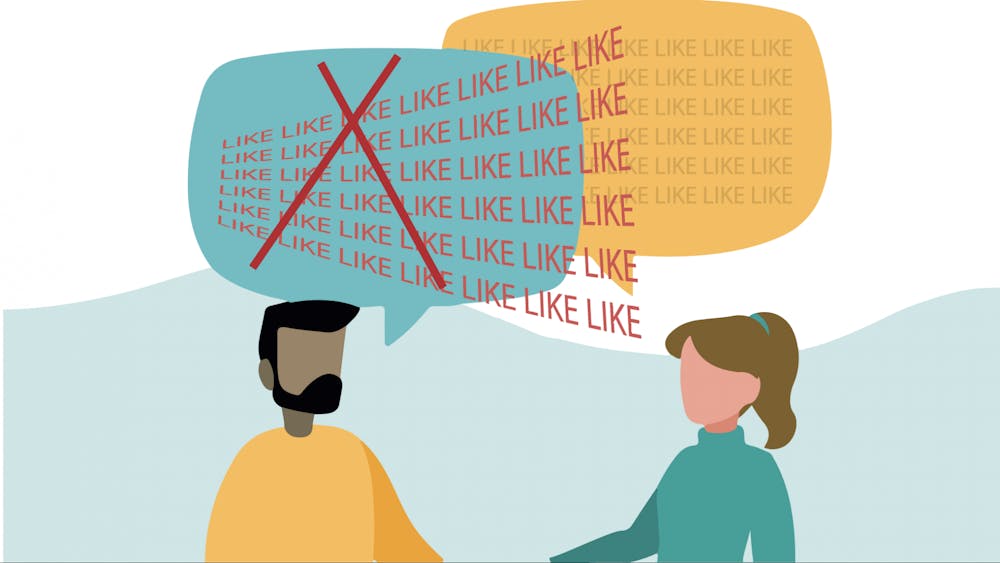“Where do you, um … like, want to, like, have lunch today?”
Whenever I hear people speaking with copious verbal fillers in a sentence, my mind starts to wander elsewhere. I start to count the number of filler words the person says rather than focusing on the actual message. Words convey meaning, but meaningless words have overtaken our daily conversations.
This pattern is especially pronounced among college students. A 2014 research paper from Charlyn Laserna showed that college students on average are three to four times more likely to use discourse markers such as “like”' or “you know” compared to people in their early and late adulthood. “This trend [that people use less fillers as they age] may be indicative of a normative life transition into adult roles, such as when one graduates from college and enters a job market,” explained Laserna.
Indeed, what we say in our everyday lives can also shape how others perceive us. James Pytko and Laura Reese asked 100 people to evaluate speakers who use varying rates of verbal fillers in their speeches. They found that people who use filler words are perceived to be unprepared, less effective at public speaking, and more difficult to be understood. In the professional world, your every move is observed and evaluated. Similarly, Nicholas Christenfeld asked a group of students to evaluate what they think when people use excessive fillers. The survey suggests that conversations with too many filler words are “uncomfortable, inarticulate, uninteresting, ill-prepared, nervous … lacking confidence.”
Like it or not, audiences make assumptions about speakers’ characters and personalities based on facial expressions, body language, voices, and words. Would you willingly submit a resume with typos or verbose descriptions of your experiences that obscure the central message? Speaking with fillers is the auditory equivalent of an unprofessional resume.
Defined as verbal fillers, words like “um,” “ah,” and “like” serve many purposes when a person speaks. Speakers use filler words to shift between conversations and involve more people into the discussion. Another common explanation is that people use fillers to get over a mind blank. Our words tend to get ahead of our thoughts when speaking in a high-pressure setting or feeling nervous.
While these uses are understandable and sometimes even necessary, repetitive use of fillers can accumulate in listeners’ minds and cause them to focus more on the use of filler words than the content.
Frederick Conrad, a methodology research professor at the University of Michigan, conducted an experiment to test the relationship between telemarketers’ success rate of obtaining an additional interview from the phone recipient and the frequency of filler words they used. The results show that their success rate decreased sharply and continuously when the filler rate increased. When the frequency of using filler words is between 0 to 1.28 fillers per 100 words, the success rate is 36%, compared to a 12% success rate when the filler rate exceeds 3.49 words per minute.
SEE MORE FROM SAM ZOU:
Improving and expanding “Exchange at Penn”
Why affirmative action is still needed in college admissions
In real life, our frequency of using filler words far exceeds the optimal rate. After analyzing over 4,000 spoken communication samples, Noah Zandan, CEO of Quantified Communications, found that the “optimum frequency is about one filler per minute” while “the average speaker uses five fillers per minute.”
If we are using too many fillers too often, how do we prevent using fillers? Practice awareness and pauses. We can turn this weakness into an advantage by replacing filler words with small pauses in our speeches.
One of the most common situations I hear someone using fillers is when answering a challenging question:
Interviewer: “So, what is the biggest challenge you’ve faced in work, and how did you overcome it?”
Interviewee: “Umm … well … you know …”
Most people rely on fillers when they think about how to answer a challenging question, or they realize that they haven’t finished their thought process while already midway through answering the question.
In these circumstances, the best rule of thumb is to simply pause. Don’t allow your facial expressions to show signs of panic or unpreparedness. Simply smile and just be quiet for a moment. And once you are prepared to answer the question, don’t start with fillers. Instead, say, “Thank you for that question” or “that’s a wonderful question!”
Pauses can feel intimidating. For many speakers, brief pauses can feel like an extended and awkward silence. But in reality, we create distorted perceptions of how fast we speak. One researcher from the College of Wooster finds that we can think at upwards to 4,000 words per minute while most examples of speech are spoken at about 120-165 words per minute. Because of such a gap, what feels like an eternity in our mind is really just a few seconds of silence.
Despite the feeling of awkwardness, sporadic pauses help you collect your thoughts, calm your nerves, and build suspense. Silence is golden. Not only does silence allow the audience to reflect on your previous message, but it also adds cadence to your speech. Speaking non-stop can appear intimidating to the listeners. The ability to pause can prove valuable to regain the audience’s attention.
Therefore, to get a head start, practice speaking without fillers now!
SAM ZOU is a College junior studying political science from Shenzhen, China. His email is samzou@sas.upenn.edu.









